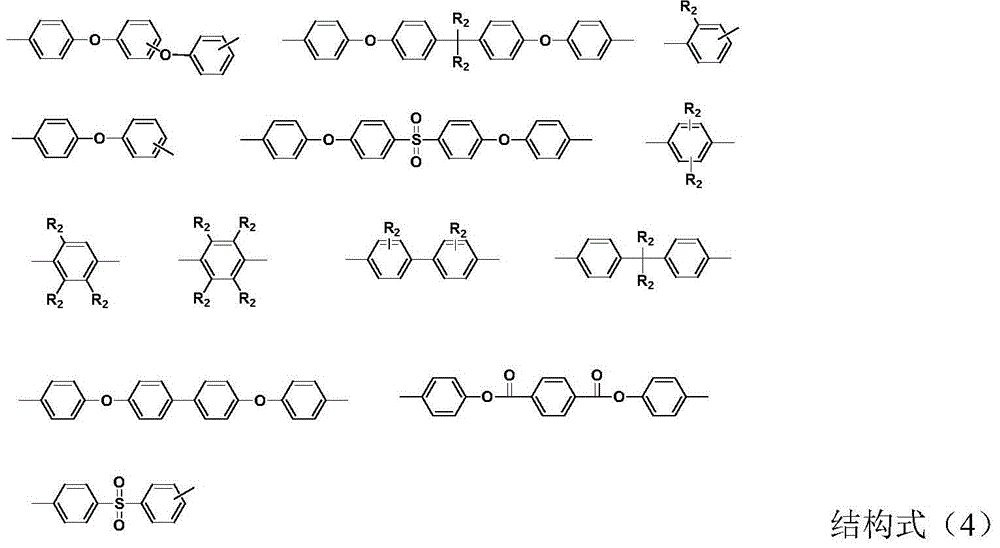Preparation method for polyamide acid solution
A technology of polyamic acid solution, which is applied in the field of preparation of polyamic acid solution, can solve problems such as unstable viscosity control and spinning difficulties, and achieve the effects of controlling the molecular weight and viscosity of the system and improving spinnability
- Summary
- Abstract
- Description
- Claims
- Application Information
AI Technical Summary
Problems solved by technology
Method used
Image
Examples
Embodiment 1
[0032] The p-phenylenediamine and 3,3',4,4'-bipyromellitic dianhydride are proportioned at a total molar ratio of 1:0.99, 10.0807g (0.1mol) of p-phenylenediamine and 225.6gN, Add N-dimethylacetamide into a four-necked flask (water content 410ppm), stir at room temperature and 2 Under protection, after complete dissolution, cool to 0℃ in an ice-water bath, slowly add 28.8120g (0.098mol) 3,3′,4,4′-bipyromellitic dianhydride powder, the feeding time is 20 minutes, and the stirring speed is After continuing the reaction at 200 rpm for 30 minutes, add 0.296 g (0.001 mol) of 3,3′,4,4′-bipyromellitic dianhydride powder to the above solution system and continue stirring for 0.5 hours to obtain a solid content of 14.8% of the desired polyamic acid solution. The solution was tested by filtration and no gel was produced. The apparent viscosity of the solution was 116 Pa·S at 25°C, and the intrinsic viscosity was 1.40 dL / g at 25°C.
Embodiment 2
[0034] The p-phenylenediamine and 3,3',4,4'-bipyromellitic dianhydride are proportioned at a total molar ratio of 1:1.01, and 10.0807g (0.1mol) of p-phenylenediamine and 358.0gN, Add N-dimethylformamide into a four-necked flask (water content 410ppm), stir at room temperature and 2 Under protection, after dissolving completely, cool to 10℃ in ice-water bath, slowly add 27.9300g (0.095mol) 3,3′,4,4′-bipyromellitic dianhydride powder, the feeding time is 30 minutes, and the stirring speed is After continuing the reaction for 45 minutes at 250 rpm, 1.764 g (0.006 mol) of 3,3′,4,4′-bipyromellitic dianhydride powder was added to the above solution system, and stirring was continued for 1.5 hours to obtain a solid content of 10% of the desired polyamic acid solution. The solution was tested by filtration and no gel was produced. The apparent viscosity of the solution was 80 Pa·S at 25°C, and the intrinsic viscosity was 1.15 dL / g at 25°C.
Embodiment 3
[0036] The p-phenylenediamine and 3,3',4,4'-bipyromellitic dianhydride are proportioned at a total molar ratio of 1:1, and 10.0807g (0.1mol) of p-phenylenediamine and 118.4gN, Add N-dimethylacetamide into a four-necked flask (water content 410ppm), stir at room temperature and 2 Under protection, after complete dissolution, slowly add 28.224g (0.096mol) 3,3′,4,4′-bipyromellitic dianhydride powder at 35°C, the feeding time is 60 minutes, and the stirring speed is 250 rpm. After the reaction continued for 120 minutes in minutes, 1.176g (0.004mol) of 3,3′,4,4′-bipyromellitic dianhydride powder was added to the above solution system, and stirring was continued for 5 hours to obtain a solid content of 25% The required polyamic acid solution. The solution was tested by filtration and no gel was produced. The apparent viscosity of the solution was 212 Pa·S at 25°C, and the intrinsic viscosity was 2.03dL / g at 25°C.
PUM
| Property | Measurement | Unit |
|---|---|---|
| Apparent viscosity | aaaaa | aaaaa |
| Intrinsic viscosity | aaaaa | aaaaa |
| Apparent viscosity | aaaaa | aaaaa |
Abstract
Description
Claims
Application Information
 Login to View More
Login to View More - R&D
- Intellectual Property
- Life Sciences
- Materials
- Tech Scout
- Unparalleled Data Quality
- Higher Quality Content
- 60% Fewer Hallucinations
Browse by: Latest US Patents, China's latest patents, Technical Efficacy Thesaurus, Application Domain, Technology Topic, Popular Technical Reports.
© 2025 PatSnap. All rights reserved.Legal|Privacy policy|Modern Slavery Act Transparency Statement|Sitemap|About US| Contact US: help@patsnap.com



